Twenty years into the millennium, South Jersey towns have changed in ways we might never have imagined. Our communities have evolved and reinvented themselves. Metropolitan downtowns have sprung out of farmland. Drug markets have turned to playgrounds. Storm-ravaged beaches have seen their grandeur restored. Two decades has seen the evolution of towns like Camden, Collingswood, Glassboro and Atlantic City, and as progress marches on, the future looks brighter than ever.
 A Brand New Day in Camden City
A Brand New Day in Camden City
Twenty years ago, Camden was at the peak of a decline that had been ramping up for decades. “Crime was high, poverty was high, unemployment was high, as was the dropout rate in the high schools,” says Camden County Freeholder Director Lou Cappelli. “At that time, Camden was headed toward being the most dangerous city in the nation, together with having the worst schools in the nation. It was not a good time in the city.”
But two decades have made a major – almost miraculous – difference in Camden. Although the city is still among the poorest in the state, Camden today boasts a growing economy, a burgeoning food scene, flourishing cultural and artistic influence, and ever-expanding opportunity for both longtime residents and newcomers.
The shift began, Cappelli says, just over six years ago, when the Camden County Metro Division was formed to replace the Camden City Police Department.
“The very first thing that needed to be addressed was public safety,” he says. “That was priority No.1. When we placed over 300 police officers out on the streets in 2013, that began a significant change to the public safety paradigm in the city.”
In the years since, crime rates have fallen by more than 50 percent (and the murder rate has dropped by 70 percent). In 2018, Camden experienced less criminal activity than at any previous point in the last two decades.
The increase in public safety coincided with an increase in educational opportunity. In 2012, the New Jersey state legislature signed the Urban Hope Act, which paved the way for a new type of charter school, called a “Renaissance School,” to open in Camden. The nonprofit institutions represented “a significant turning point,” Cappelli says, “because it forced schools to compete for students, and the outcome is a much better system of education and much better educational opportunities.”
As the schools improved, and things began looking up for the children of Camden, community leaders recognized those same kids who now had a safe place to learn also needed safe places to play.
“If the goal of rebuilding a city is to keep people in the city, and you want to keep them in their neighborhoods, you have to improve the infrastructure, including the parks,” says Jeffrey Nash, freeholder liaison to the Camden County Parks Department. “We started at a place where it was recognized that Camden City had the worst parks in the county. They were old, dilapidated, frequented by undesirable people, and full of drug and gang activity. We were going to rebuild from the ground up.”
The county, alongside Cooper’s Ferry Partnership and other community groups and leaders, started with North Camden’s Pyne Poynt Park. “We worked with the community to develop the park they wanted to see,” Nash says.
Today, after a $3 million renovation, Pyne Poynt is home to the North Camden Little League, and has become a model for park upgrades in Camden and beyond.
In addition to investment in the city’s children, there’s been an enormous shift in Camden’s economy. Cappelli points to the Economic Opportunity Act of 2013, “without which you wouldn’t see $2.5 billion in investment and the creation of thousands of jobs in the city” thanks to companies such as American Water and Holtec relocating their headquarters to the waterfront.
2019 marked another important turnaround when 11 Cooper, the first new high-end apartment building, opened on the Camden waterfront. It came on the heels of the groundbreaking of the city’s first new hotel in 50 years. More than 1,000 housing units are currently being built or renovated in the city, according to Cooper’s Ferry Partnership.
Big business is also moving in, including the global headquarters of ResinTech Inc. The $138.8 million project is expected to be completed later this year.
As things shift and Camden is pulled into the future, there’s also been a concerted effort not to leave behind the city that’s already there.
“My understanding is about 800 of those jobs have been created for Camden residents, and that number’s going to grow,” Cappelli says. “There’s been absolutely zero gentrification during this renaissance.”
He’s immensely proud of how far Camden’s come in twenty years, but Cappelli certainly isn’t satisfied. The next project he hopes to see completed is a “redevelopment of the Walter Rand Transportation Center into a modern hub for the city.” There are more park renovation plans in the works, too, with green spaces in different corners of Camden currently undergoing renovation and enhancement.
“When you take a place that’s a hub of illegal activity and broken-down equipment and make it a place for kids to go and play, it turns the entire community around,” Nash says. “Alone, the park improvement doesn’t make a significant difference, but add it to the rest of what’s happening and it’s a hugely important component. As a city is being revitalized and people are taking advantage of new opportunities and better schools, it’s just one more reason to stay.”
Aviation and Academics in Atlantic City
Atlantic City, South Jersey’s historic capital of entertainment, is a place that’s experienced a lot of ups and downs over the years, says Assemblyman Vince Mazzeo.
“In the 1970s, Atlantic City wasn’t doing too well,” says Mazzeo, who represents Atlantic County. “Then the first casinos went up, and it brought about this great run for more than 30 years. Until competition started to increase in the early 2000s, Atlantic City’s casinos were a $6 billion industry.”
But in the last decade, the city’s been through some more tough times. Five casinos shut their doors between 2014 and 2016, eliminating jobs and sending the city to the brink of bankruptcy.
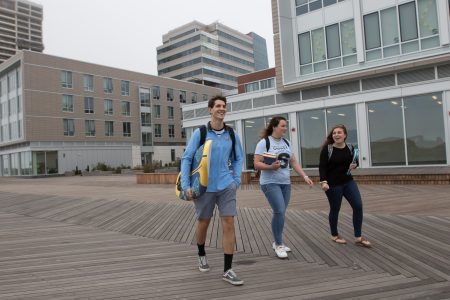
Stockton University students can go from studies to surf at the Atlantic City campus
“But Atlantic City always seems to rebound,” Mazzeo says. It certainly did in 2012, after Superstorm Sandy made landfall, destroying 346,000 homes across the state and turning parts of the shore into federal disaster areas, derailing tourism for the next several years.
Reconstruction is still ongoing, with the state recently proposing $20 million in projects like bulkhead construction and flood-proofing City Hall and other public buildings. While that work is expected to continue until at least 2022, Mazzeo says tourism numbers have rebounded nicely.
“The casinos have recovered, and there are nine open now,” Mazzeo says. “But we’re reinventing Atlantic City again, and diversifying the economy. There’s a lot more here. We have the beach, the boardwalk, and the casinos.”
Part of that economic diversification will happen at the Atlantic City airport, thanks to a $100,000 grant awarded to Atlantic County in 2018 by the New Jersey Economic Development Authority to help develop an aviation and technical academy.
“It has the potential to bring in thousands of new jobs,” Mazzeo says. “They already have the Federal Aviation Administration’s research and technology center there. We’re working together with this idea of aviation research and development coming to Atlantic City.”
It’s not only pilots and aviation engineers who are getting an education in Atlantic City. In 2018, Stockton University opened a new campus at the intersection of Albany, Atlantic and Pacific Avenues.
“Stockton has always been committed to Atlantic City,” says Brian Jackson, COO of Stockton University. “The school’s first classes were here in Atlantic City, before the main Galloway campus was constructed. Since then we’ve had a presence at the former Carnegie Library, and we’ve had the Noyes Arts Garage and Dante Hall Theatre, anchors in the cultural and arts district. There was always a desire of the university to expand our presence here.”
The $220 million development, which Stockton called The Gateway Project, sits on the site of the former Atlantic City High School and includes 15 classrooms, dining space and a multipurpose room. Across the street is a residential building that includes rooms – most of them with sweeping beach views – for more than 530 students.
“There’s a strong love and dedication and commitment from people who grew up here or attended Atlantic City High School,” says Jackson. “They’re just so excited to see education back on the site.”
Family, fraternity and the future of Glassboro
A little over two decades ago, an industrialist named Henry M. Rowan announced that he wanted to give $100 million to Glassboro State College, then known primarily as a small teachers’ college. The rest, as anyone in Glassboro today will tell you, is history.
“The school said, ‘Listen, with $100 million we can build a fabulous thing, but no one will come if the town is not made a better place,” says Les Vail, president and CEO of the Gloucester County Chamber of Commerce. “At the time, the downtown had gone away. It was either frat houses or run-down buildings.”
Today, Glassboro’s thriving, walkable downtown belies that recent history. Ali Houshmand, president of Rowan University, credits the town’s leadership for having the foresight to buy 26 acres of land that’s now become the beautifully developed Rowan Boulevard.
“For them to take that risk was critical in sparking a development that benefits everybody,” Houshmand says. “It was an investment in the future of the town.”
In the past few years, new boutiques, bookstores, restaurants and cafes have moved in along the Boulevard. Property values have skyrocketed, and so, according to Mayor John Wallace, has the sense of community in Glassboro.
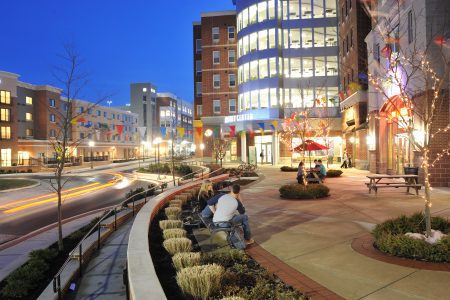
Rowan Boulevard links Glassboro’s downtown to the university
“Our town square is what I’m proudest of. Five years ago, it was an old radiator shop,” he says. “Now it’s just an absolutely beautiful square with fountains, chairs, a fire pit. It gets used on a daily basis, and we host events there that pull everybody together.”
The town of Glassboro and Rowan University consider themselves partners in a development plan that has – and will continue to – transform both the school and the surrounding community.
“One of the tricks is embracing the college town atmosphere, but holding onto the ‘small town’ feel that Glassboro has once school is out,” Wallace says. It has to be a place, he explains, where families and frat houses can happily co-exist. “Fortunately, we have a wonderful relationship with the University.”
And while Glassboro has evolved and grown, Rowan’s been doing some serious expanding of its own.
“Now we’ve got this university that is much more than a teachers’ college; it’s a nationally-known research institution with one of the top engineering schools and two medical schools,” Vail says. “I’m amazed when I just sit back and look at the changes. A few years ago, Rowan had 10,000 students. Now there’s more than double that, and it’s continuing to grow.”
Houshmand says that kind of growth wouldn’t be possible without the businesses that have moved in to serve the community, the restoration of the downtown and the college-town feel Glassboro has fostered.
“It’s made the University much more attractive and popular, especially to the residents of northern New Jersey,” Houshmand says. “Instead of crossing the river and going to private schools [in New York City], they’re seeing us as an option. We’re an internationally recognized research institution and they pay in-state tuition.”
Glassboro is a different town today compared to two decades ago (if you haven’t visited and strolled Rowan Boulevard yet, what are you waiting for?), but Wallace says there’s much more left to accomplish. Over the next 20 years, he hopes to witness a re-investment in the business corridor on Route 322 and see a long-planned light rail project come to fruition.
“I would love it to be a quintessential college town, where the power of the university brings investment in the community,” Houshmand says. “That’s my greatest wish. Glassboro is a diverse place. Immigrants came in 50, 100 years ago, and they’re still here. At the same time, you’re bringing a whole new class of people from around the world here. To be part of creating this beautiful place is a wonderful feeling, and it makes me very proud.”
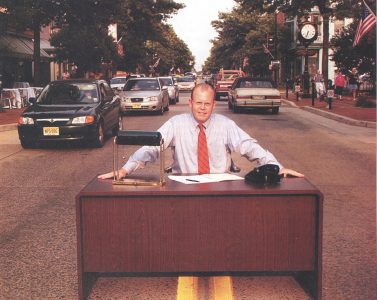
Collingswood Mayor Jim Maley stopped traffic for our photo shoot in 2003; Photo: David Michael Howarth Photography
Twenty years ago, as the redevelopment of the once-economically depressed Collingswood was hitting its stride, Mayor Jim Maley was trying to get chefs and restaurateurs to share a vision for the future.
“We knew that restaurants would be our anchor,” Maley says. At first, there was a lot of criticism. Collingswood is a dry town; if restaurants couldn’t get liquor licenses, some believed, they didn’t stand a chance at success.
The town hosted a conference and courted chefs from across the region, asking them to take a risk and assuring them, Maley says, “that we’d bend over backwards for them.” The gamble paid off. One of the keystones in Collingswood’s restaurant renaissance was Villa Barone, which began as a modest pizza place.
“I went in constantly to say, ‘Hey, your food’s great, let’s get rid of these booths and plastic cups,” Maley says. Today, Villa Barone has expanded to fill multiple storefronts, and offers an upscale — and deeply authentic — Italian menu without a plastic cup in sight.
At present there are 47 restaurants, cafes and eateries along Haddon Avenue, representing a huge variety of cuisines, atmospheres and price points. Options range from native Hawaiian cuisine at Aloha Poké Bowl to the award-winning Sicilian fare of Zeppoli. Diners looking for Mexican, Thai, Japanese, Indian or Mediterranean food can find it all in the span of a few blocks. It’s still a dry town, but that, says Cass Duffey, director of community development, has worked in Collingswood’s favor.
“People are shocked at the incredible meals they’re getting, and they turn over the check and it’s so much less than you’d normally spend, because you brought along your own bottle of wine,” she says.
Collingswood’s culinary culture has propped up the rest of its business community.
Foot traffic on Haddon Avenue has increased exponentially and, Duffey adds, plenty of diners make visiting Collingswood an event.
The rest of the culinary world is noticing Collingswood. Last year two local restaurants — Zeppoli and Sagami — were shortlisted for prestigious James Beard awards. At certain times of year, the wait to get into Haddon Avenue’s most popular spots can be months long.
“I can go right around the corner from my house and have one of the most phenomenal meals of my life,” Duffey says. “If I can get a reservation.”


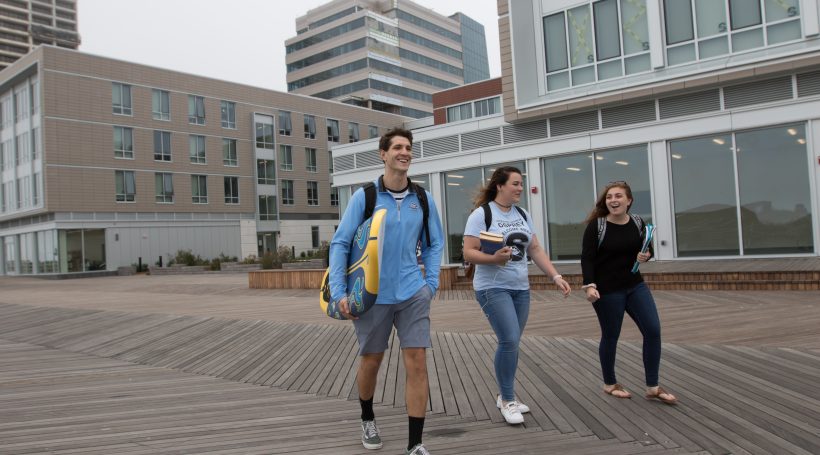
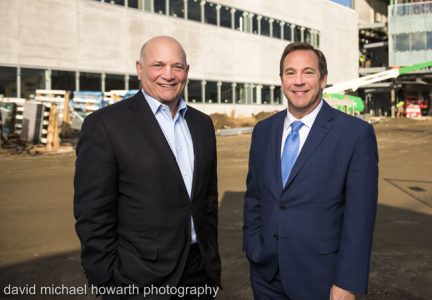 A Brand New Day in Camden City
A Brand New Day in Camden City










